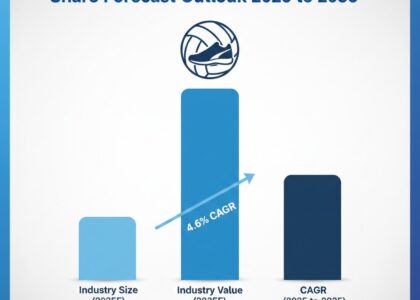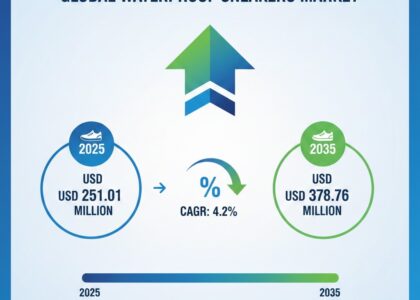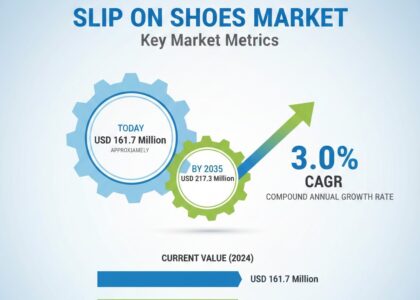Owing to the growing need for new drug classes, demand for oligonucleotide APIs is projected to rise at a high CAGR of 5.60% from 2024 to 2034. As such, the global oligonucleotide API market is projected to increase from a valuation of USD 2.81 billion in 2024 to USD 4.84 billion by the end of 2034.
The oligonucleotide API market has emerged as a vital segment within the pharmaceutical and biotechnology landscape. These APIs, or active pharmaceutical ingredients, are synthetic strands of nucleotides that play a crucial role in genetic research, diagnostics, and the development of novel therapeutics. The surge in personalized medicine, particularly in targeting genetic and rare diseases, has significantly increased the demand for oligonucleotide-based drugs. With advancements in gene editing, molecular diagnostics, and RNA-based therapeutics, the oligonucleotide API market is undergoing rapid transformation and expansion.
Increasing application in therapies such as antisense oligonucleotides, small interfering RNAs (siRNAs), and microRNAs (miRNAs) have placed these molecules at the forefront of next-generation medicine. The market is supported by a growing number of clinical trials and approvals for oligonucleotide-based drugs. In this dynamic environment, manufacturers are scaling up production capacities while ensuring stringent quality standards to meet the rising demand.
Get Sample Report: – https://www.futuremarketinsights.com/reports/sample/rep-gb-11933
Market Trends
A notable trend in the oligonucleotide API market is the integration of automation and artificial intelligence in manufacturing processes. As these APIs require high precision and purity, companies are investing in advanced technologies to streamline production and improve yields. Continuous manufacturing processes are being adopted to enhance scalability and reduce the risk of contamination, which is especially critical in oligonucleotide synthesis.
There is also a rising trend of outsourcing API manufacturing to contract development and manufacturing organizations (CDMOs). Many pharmaceutical companies are leveraging the expertise and infrastructure of CDMOs to reduce operational costs and accelerate time-to-market. Additionally, green chemistry and sustainable production practices are gaining prominence, as regulatory bodies and stakeholders push for environmentally responsible manufacturing.
Another trend shaping the oligonucleotide API market is the development of novel delivery systems. Efficient delivery of oligonucleotide therapeutics to target cells remains a challenge, prompting innovation in nanoparticle carriers, lipid nanoparticles, and conjugation strategies that enhance bioavailability and target specificity.
Driving Forces Behind Market Growth
Several factors are fueling the growth of the oligonucleotide API market. The expanding field of precision medicine is a primary driver, as oligonucleotide-based therapies offer the ability to target specific genetic sequences, enabling more effective treatment of diseases with a genetic component. This is particularly relevant for rare and orphan diseases, many of which lack effective treatment options.
Another driving force is the increasing prevalence of chronic and lifestyle-related diseases, such as cancer, cardiovascular diseases, and neurological disorders. Oligonucleotide APIs are being explored for their potential in modulating gene expression associated with these conditions. The surge in research funding from public and private sectors is further propelling the market, enabling the discovery and development of novel oligonucleotide-based candidates.
Regulatory support also plays a crucial role. Agencies like the FDA and EMA are providing clearer guidelines for the approval of oligonucleotide-based drugs, facilitating a more predictable development pathway. The rising acceptance of these therapeutics is also contributing to growing investor confidence and capital flow into the market.
Challenges and Opportunities
Despite its promising outlook, the oligonucleotide API market faces several challenges. One of the foremost issues is the complexity of manufacturing. Synthesizing oligonucleotides involves multiple steps and requires high levels of precision and quality control. This makes the process costly and time-consuming, particularly for large-scale production.
Additionally, stability and delivery remain significant concerns. Oligonucleotides are prone to degradation, and effective delivery to target cells is often difficult. These challenges necessitate further innovation in formulation and delivery mechanisms. Regulatory compliance and the need for specialized facilities and skilled personnel also add layers of complexity to market entry.
However, these challenges bring with them a wealth of opportunities. Companies investing in advanced manufacturing platforms and novel delivery technologies stand to gain a competitive edge. There is also a growing demand for customized oligonucleotide synthesis, particularly in the research and diagnostics sectors, presenting new revenue streams for established players and new entrants alike.
Recent Industry Developments
Recent developments in the oligonucleotide API market reflect a rapidly maturing industry. Several biopharmaceutical companies have announced successful clinical trials and regulatory approvals for oligonucleotide-based therapies, particularly in the areas of neuromuscular diseases and metabolic disorders. These approvals underscore the therapeutic potential and growing acceptance of this class of drugs.
There has also been an uptick in strategic partnerships and acquisitions. Large pharmaceutical firms are partnering with specialized biotech companies to co-develop oligonucleotide therapies, while CDMOs are expanding their capabilities through acquisitions to meet growing client demands. Furthermore, several firms are investing in new facilities dedicated to oligonucleotide production, signaling long-term commitment to this market segment.
Innovations in analytical technologies are also shaping the industry. High-throughput screening and real-time monitoring systems are being employed to ensure product integrity and compliance with regulatory standards. These advancements are enabling companies to scale operations while maintaining quality, a crucial factor in commercial success.
Regional Analysis
Regionally, North America dominates the oligonucleotide API market, driven by strong R&D infrastructure, a high concentration of biotechnology firms, and supportive regulatory frameworks. The United States, in particular, is home to many of the leading players in the space, along with robust academic research institutions that contribute to innovation.
Europe also holds a significant share, with countries like Germany, the UK, and France at the forefront of oligonucleotide research and development. The region benefits from well-established healthcare systems and favorable government policies that encourage biotechnological innovation.
In the Asia-Pacific region, rapid market growth is expected due to increasing investments in pharmaceutical manufacturing, especially in countries like China, India, and South Korea. These countries offer cost-effective production capabilities and are investing in infrastructure and talent development to support complex API manufacturing.
Emerging markets in Latin America and the Middle East are also showing interest in oligonucleotide therapeutics, although growth in these regions is currently slower due to regulatory and infrastructural challenges.
Competitive Outlook
The competitive landscape of the oligonucleotide API market is characterized by a mix of established pharmaceutical giants, specialized biotech firms, and agile CDMOs. The market is moderately fragmented, with companies vying to differentiate themselves through innovation, quality, and scalability.
Key competitive strategies include investment in proprietary synthesis technologies, expansion of production capacities, and forming strategic alliances to access new markets and capabilities. Intellectual property plays a critical role, with firms aggressively securing patents to protect novel sequences and synthesis methods.
Additionally, companies that can demonstrate regulatory compliance and robust quality assurance processes have a significant advantage. As more oligonucleotide-based therapies move through clinical pipelines, the ability to meet growing and diverse production demands will be a key differentiator.
Top Companies
Several companies are leading the charge in the oligonucleotide API market. These include industry giants like Thermo Fisher Scientific, Merck KGaA, and Agilent Technologies, which offer a wide range of oligonucleotide synthesis services and products. Their extensive experience and global footprint give them a competitive edge in both research and therapeutic applications.
Other notable players include Nitto Denko Avecia, LGC Biosearch Technologies, and Eurofins Genomics, which specialize in custom synthesis and have strong capabilities in both small- and large-scale production. Biotech firms like Ionis Pharmaceuticals and Alnylam Pharmaceuticals, though focused primarily on drug development, also play a pivotal role in shaping market dynamics through their pioneering research.
These companies are continuously innovating and expanding their service offerings to cater to a growing and diverse client base. Strategic collaborations, technology licensing, and infrastructure investments remain central to their growth strategies.
Explore In-Depth Analysis-Click Here to Access the Report:- https://www.futuremarketinsights.com/reports/oligonucleotide-api-market
Segmentation Outlook
The oligonucleotide API market can be segmented based on type, application, end-user, and synthesis method. By type, the market includes antisense oligonucleotides, siRNA, miRNA, and aptamers. Antisense oligonucleotides currently hold a significant share, owing to their proven efficacy in targeting genetic disorders.
In terms of application, therapeutics dominate the market, driven by increasing approvals and clinical pipeline expansion. However, research applications and diagnostics also constitute a substantial segment, particularly in academic and clinical laboratory settings.
End-users include pharmaceutical and biotech companies, academic research institutes, and diagnostic labs. Pharmaceutical companies form the largest user group, followed by research institutions investing in gene-related studies.
Synthesis methods include solid-phase synthesis, liquid-phase synthesis, and enzymatic synthesis. Solid-phase synthesis remains the most widely adopted due to its scalability and efficiency, although innovations in enzymatic synthesis are gaining interest for their eco-friendliness and cost-effectiveness.
As the market evolves, the interplay between these segments will continue to shape growth trajectories and innovation trends, making the oligonucleotide API market a focal point of next-generation pharmaceutical development.
About Future Market Insights (FMI)
Future Market Insights, Inc. (ESOMAR certified, recipient of the Stevie Award, and a member of the Greater New York Chamber of Commerce) offers profound insights into the driving factors that are boosting demand in the market. FMI stands as the leading global provider of market intelligence, advisory services, consulting, and events for the Packaging, Food and Beverage, Consumer Technology, Healthcare, Industrial, and Chemicals markets. With a vast team of over 400 analysts worldwide, FMI provides global, regional, and local expertise on diverse domains and industry trends across more than 110 countries.
Contact Us:
Future Market Insights Inc.
Christiana Corporate, 200 Continental Drive,
Suite 401, Newark, Delaware – 19713, USA
T: +1-347-918-3531
For Sales Enquiries: sales@futuremarketinsights.com
Website: https://www.futuremarketinsights.com
LinkedIn| Twitter| Blogs | YouTube





